Attention citizen gardeners! We need your help in creating demand for an unsung hero of the pollinator garden, Cowpen Daisy, Verbesina encelioides. To get this plant some well-deserved attention, we’re naming it “San Antonio’s unofficial pollinator plant of the year” for 2019.
Local nurseries and growers often cite a lack of demand as the reason many native plants are commercially unavailable. Let’s create the demand.
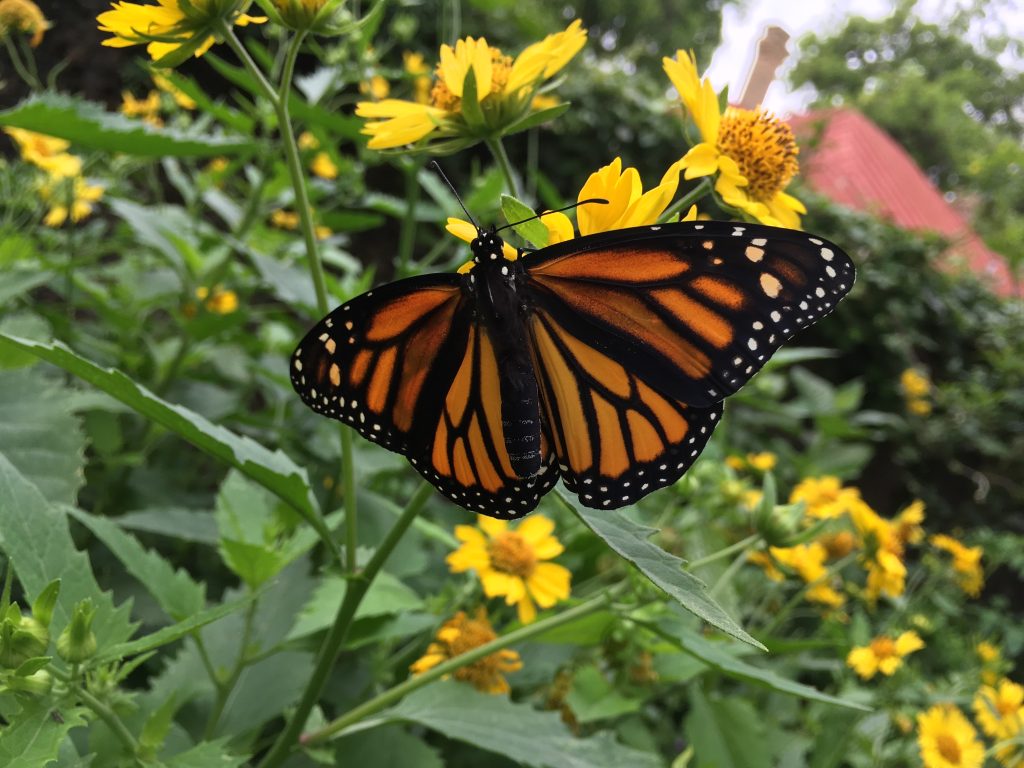
Monarch butterfly on Cowpen Daisy in downtown San Antonio pollinator garden. Photo by Monika Maeckle
Cowpen Daisy, like many worthy-but-unappreciated native plants, can only be found at pop-up plant sales staged by organizations that understand the importance of appropriate pollinator landscaping. If you happen to miss these occasional events, tough luck.
And yet Cowpen Daisy, also known as Golden Crownbeard and Butter Daisy, is ideal for our climate, and native to 30 states. It’s drought tolerant, easy to grow, a prolific bloomer from late March through November and beyond.
This overachieving member of the aster family plays host plant to the Bordered Patch Butterfly, Chlosyne lacinia, and at least one species of moth. It provides nectar almost year-round to myriad pollinators. Bees love it. It’s deer resistant. And birds appreciate its prolific seeds in the fall and winter, which form bulbous brown heads.
“There are lots of pros to this plant,” said Lee Marlowe, sustainable landscape ecologist at the San Antonio River Authority (SARA). “It’s native to our area, has lots of attractive yellow blooms, it attracts pollinators, and birds can eat the seeds.”
Marlowe said that since Cowpen Daisy is a self seeding annual, it may result in “lots of seedlings that may be too much work for some gardeners.” But she added that this could also be a plus since the seedlings can be moved to other areas of the garden, shared with friends, or “simply left in place to expand their Cowpen Daisy patch for an even bigger flower show.”
Marlowe said the San Antonio River Authority already has Cowpen Daisy installed on the award-winning Mission Reach Riparian Restoration along the San Antonio River. SARA has plans to add more with seeds shared by the Texas Butterfly Ranch.
Julie Marcus, senior horticulturist at the Lady Bird Johnson Wildflower Center, also acknowledged Cowpen Daisy’s appeal.
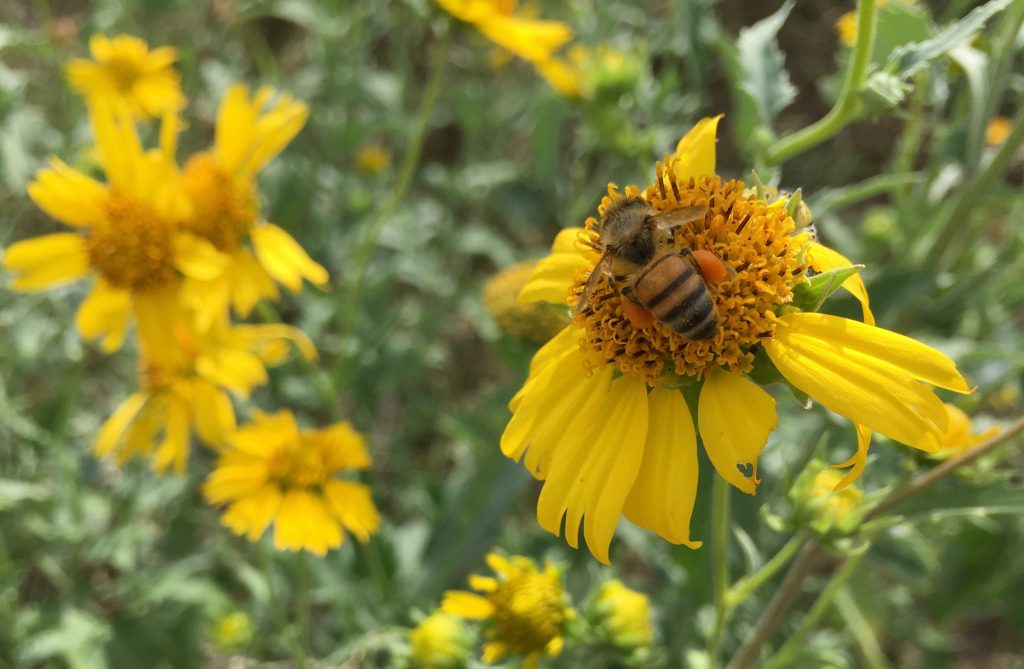
Honeybee on Cowpen Daisy. Check out those pollen baskets! Photo by Monika Maeckle
“It’s a disturbance plant, and literally grows around the cowpens,” said Marcus, adding that Cowpen Daisy has made regular appearances in the Wildflower Center’s pollinator garden for years.
“We all love it…It’s a tough plant–drought resistant, a pollinator attractant, I guess some people might see cons, as it can be weedy…but all wildflowers are weedy,” she said. Marcus also pointed out that Cowpen Daisy has healing properties and was used by indigenous peoples to treat skin ailments and inflammation.
We have no official endorsement from our elected officials for this citizen gardener effort in San Antonio. But we do we have commitments from friends at the Native Plant Society, Gardening Volunteers of South Texas, Bexar County Master Gardeners, City of San Antonio horticulture staff, San Antonio Water Services, San Antonio Botanical Garden, Greenhaven Landscaping, the Nectar Bar, San Antonio River Authority and others to help us promote and grow this under-appreciated pollinator garden superstar. These groups have agreed to grow Cowpen Daisy this year to make them available and visible in our community.
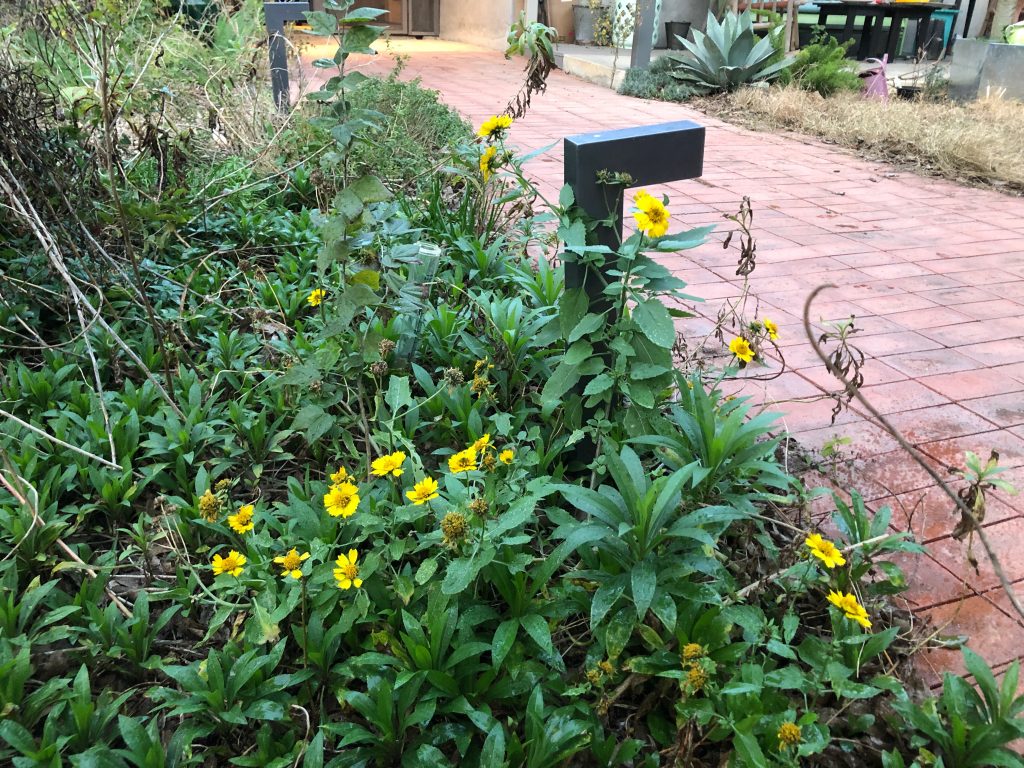
Cowpen Daisy flowers much of the year. Still blooming, February 3, 2019. Photo by Monika Maeckle
Our successful 300for300 initiative in 2018 demonstrated that when gardeners take action, we can make a difference. We set out to create 300 pollinator gardens for San Antonio’s 300th birthday. By December 31, we had pledges for 325 gardens, exceeding our goal by almost 10 percent. Today, we’re up to 339 gardens.
Check out the map of our gardens and feel free to sign up–we will continue to encourage our community to make gardening choices that are healthy for the landscape.
You can help raise awareness and reinforce our efforts by asking your local plant suppliers to stock Cowpen Daisy. Each time you go to your favorite local nursery, HEB or big box store gardening center, ask the sales clerk or plant buyer: “Do you have Cowpen Daisy? I’ve been hearing so much about it.”
Watch for Cowpen Daisy updates here at the Texas Butterfly Ranch and look for plugs at upcoming plant sales. Can’t wait? Order seeds from our friends at Native American Seed. They are quick to germinate, and we’ll cover that in a future post.
While supplies last, we’ll send a FREE packet of Cowpen Daisy seeds to anyone who orders one of our pollinator signs.
Together, perhaps we can create the demand that will make this plant commercially available.
TOP PHOTO: Bordered Patch butterfly on Cowpen Daisy
Related posts:
- How to plan a successful butterfly garden
- Mostly native butterfly garden outperforms lawn every time
- A year in the life of an urban butterfly garden
- Downtown River walk plot converts to pollinator garden, creature haven
- Converting your Lawn to a Butterfly Garden
- San Antonio becomes first National Wildlife Federation Monarch Champion city
- Tropical Milkweed: To Plant it or Not is No Simple Question
- How to raise Eastern Swallowtails
- How to raise Monarch butterflies at home
Like what you’re reading? Don’t miss a single post from the Texas Butterfly Ranch. Sign up for email delivery, like us on Facebook, or follow us on Twitter, @monikam.

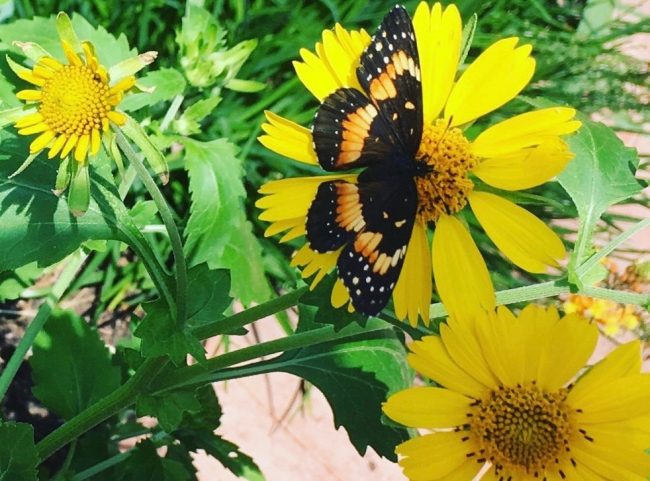
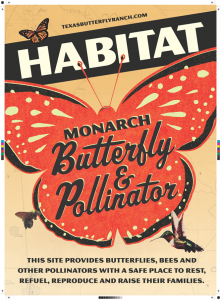
Thanks Monika for this beautifully written ‘expose’ for the Cowpen Daisy. It’s one of Texas’ best kept secrets! It stands low temperatures and cold fronts which reduce the temperature to less than 32 degrees and it still keeps on blooming. The blue-green foliage is beautiful and much appreciated. We’ve grown it in hundreds of sites for more than 40 years. A truly great addition to a pollinator garden.
Charles M. Bartlett, President
Green Haven Industries, Inc.
Thank you! Stay tuned–we have just scratched the surface of this native bloomer’s massive charms. 😉
Love it. Thank you for the wealth of info. I signed up last week and ordered a sign, do orders from last week get free cowpen daisy seeds? *crosses both fingers and wishes very hard*
Sure, butterflies and birds love it, but this plant is an aggressive weed. You may come to regret planting it.
I clicked on the native American seed & went to order the seeds but when shipping came up at $24.00 I said I don’t think so!
Robert, Thanks for taking the time to leave a comment. I’m looking into this and have a few questions. What zipcode are you trying to ship to? Also, which shipping & handling option did you select at checkout? Please feel free to call our office 800.728.4043 and we will make sure to get you the most cost effective shipping option that meets your expectations on delivery times.
80916. Standard is what came up
I would like to create a “field” of cowpen daisies among the clumps of little bluestem on my hill country land. Last fall I pulled up the huge cowpen daisy plants from the garden when they were done blooming and pitched them into the bluestem areas, hoping that some of the seeds would make their way down to the soil and germinate this spring. Does anyone have an experience with this type of “seeding”? I’m hoping the effect might be that of a sunflower field that would grow from year to year as more plants bloomed and their seeds dropped. But prairie grasses are pretty tough competitors and I do not want to try and remove them.
I would appreciate it if you could add information like growth height, sun exposure required, moisture requirement and width of spread.
Thank you,
Jann
My experience is that Cowpen is a bit of a disturbance plant and is early to the party of disrupted soil. It eventually will get crowded out if aggressive plants compete with it, but it can also create a carpet of seedlings that are esay to pull out or move.
It can do with less light, but thrives in full sun and can grow to 5-6 feet. But you can also cut it back and keep it low. Keep deadheadding and it will keep putting out. Super versatile, asks for little water, but obviously appreciates it.
Discovered this plant when we put in a new road at the ranch and the perimeter of the road was lined with these yellow bloomers the following spring.Then it started showing up in other areas—always in bare spots. In our recent LlAno River flood, the only plant blooming a month after the waters receded was Cowpen Daisy.
Took some home and now it’s everywhere in my coddled garden. I pull most of it out and just choose a few to allow to get big and servr as foundation plants. Later in the season, the Bordered Patch butterflies show up and start consuming the leaves—but no worries, there’s plenty for everybody.
Good luck, and thanks for giving it a try! —Monika
Yes! Cut them back a bit. Good luck!
I transplanted three pots of CP Daisies. Cut them back some as you suggested. They struggled for about a week and then really took off. They are beautiful.
They are super easy and tough!! I love them and have plants to share for anyone in the NW Austin area. I am in Leander and introducing them to a Burnet property. This is one of those plants no one seems to know about like Frostweed and Texas Yellow Stay (Linheimer) that are tremendous assets to wildlife and easy as pie!
Dear Monika,
The ranch where I work in Zapata County has a plethora of “Cowpen Daisies” in the pastures. Can I transplant some of them into a pot and bring to my home in Laredo? Do you think that will work?
A good plant with healing properties. And not whimsical, it’s good. I like your post!
The only plant in North central Oklahoma which has nectar in it at the time the monarchs are migrating…It’s their 7-11…It is tolerant to the shade of single oak trees…I’ve watched it for several years and there is nothing else they hit on…I am in the process of trying to harvest some seed…Hennessey, Oklahoma…
I have them growing wild in a mass in river rocks and gravel in Placitas, New Mexico, south of Santa Fe at 5,000 feet. If I don’t water them they will bloom at 5 inches tall and if I do water weekly they will bloom at 5 feet tall.
Wild horses so not eat the flowers or plant.
Wild horses don’t eat the flowers or the plant.
One of my favorite plants and an exceptional Pollinator Magnet! I send seeds in Christmas cards to my gardening friends. I gave away some plants in my local Buy Nothing group. I gave seeds away to students when I taught a NPSOT Landscaping With Native Plants class at the Inks Dam National Fish Hatchery in Burnet TX. So easy to grow in a pot or in the ground.